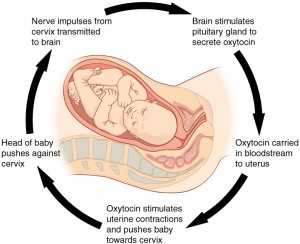Difference Between Baby moving and Contractions
 Introduction:
Introduction:
The movement of the baby in the womb during pregnancy and the painless uterine contractions that occur during the course of pregnancy are quite difficult to differentiate between. These movements are undoubtedly one of the best feelings of pregnancy but the two definitely differ in terms of their origin and nature. However, a mother can easily differentiate between the two more so during her subsequent pregnancies after having the first baby.
Difference in nature:
The baby starts moving in the womb by the 16th week of pregnancy. The movements of the head, hands, and legs are felt as small kicks or bumps to the mother. These movements keep increasing as the pregnancy progresses and decrease towards term. The decrease in movements is due to lack of space to the growing fetus as well as because towards the 35th week the head of the baby gets fixed into the mother’s pelvis.
The contractions of the uterus arise from the musculature of the uterus. These contractions that occur during pregnancy do not have any pathological cause and are believed to be due to an irritated uterus. These contractions start from the 6th week of the pregnancy. These sudden movements of the abdomen occuring as a part of a normal pregnancy, without posing any danger to the baby or the mother, are known as Braxton Hicks contractions. The contractions of the uterus that occur at term are painful contractions in order to expel the fetus out of the uterus.
Difference in the factors affecting:
The movements of the baby in the womb are felt better by thin mothers than by plump or obese mothers. The frequency of the baby moving is not fixed. Sometimes the baby may move and kick several times in a day or these movements may remain absent for several hours or even a day or two. However, if the baby does not move for a very long time it is advisable to contact the doctor immediately. The baby moving is also affected by the state of the mother. Movements of the mother lull the baby to sleep so the movements of the baby will not be felt. When the mother is at rest or asleep the movements of the baby increase. Also, when the mother is nervous or scared the adrenaline rush causes the baby to move more frequently. A surge in the blood sugar levels of the mother like after a snack or after a meal the baby moves more due to a surge in energy.
The uterine contractions are irregular, infrequent and essentially painless. These occur at any time and do not have any relation with the movements of the mother or her emotional status. These contractions if occurring more frequently can sometimes make the mother uncomfortable. It is best to keep the mother well hydrated to avoid irritability of the uterus. When these contractions start occurring close together and become rhythmic and painful one can be sure that labour has set in.
Summary:
The baby moving and uterine contractions are very different from each other but are difficult to differentiate by women during their first pregnancy. The movements of the baby are felt as early as in the 16th week of pregnancy and are greatly affected by the movements and emotional state of the mother. The contractions of the uterus are painless and irregular movements of the uterus that start by the 6th week of pregnancy and do not have any relation to the mother’s state of mind or movements.
- Difference between near sightedness and far sightedness - January 21, 2015
- Difference between Diverticulosis and Diverticulitis - January 20, 2015
- Difference between Prilosec and Nexium - January 19, 2015
Search DifferenceBetween.net :
Leave a Response
References :
[0]http://upload.wikimedia.org/wikipedia/commons/9/9a/106_Pregnancy-Positive_Feedback.jpg

 Introduction:
Introduction: